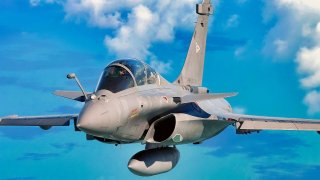Dassault Rafale: The Fighter Jet Every Air Force Wants to Fly
The Dassault Rafale, a French fighter platform that first flew in the mid-1980s, has recently seen a surge in popularity, becoming the second most purchased Western fighter since 2022, trailing only the F-35.
Summary: The Dassault Rafale, a French fighter platform that first flew in the mid-1980s, has recently seen a surge in popularity, becoming the second most purchased Western fighter since 2022, trailing only the F-35. This versatile aircraft, capable of conducting air supremacy, reconnaissance, and ground support missions, has been ordered by multiple countries including Greece, the UAE, Indonesia, Egypt, Qatar, and Croatia, in addition to the French military. With over 495 orders since the start of 2024, questions arise about Dassault's capacity to meet this demand. The Rafale's appeal lies in its robust performance, significant payload capacity, and advanced electronic systems, offering a strong alternative to American and Russian jets.
Dassault Rafale: The Rising Star in Global Fighter Jet Sales Surpassing All but the F-35
A 20-year-old French fighter platform has surged in popularity. In fact, since 2022, the Dassault Rafale has outsold every other Western fighter other than the Lockheed Martin F-35 Joint Strike Fighter.
This enduring platform took its maiden flight in the mid-1980s and has been ordered by Greece, the United Arab Emirates, Indonesia, Egypt, Qatar, and Croatia, as well as the French navy and air force. Since the beginning of 2024, 261 Rafales have been ordered by various militaries. France has also procured an additional 234 of the fighters, which has some analysts wondering whether manufacturer Dassault can actually produce all these jets in a timely manner. Regardless, the Rafale’s rise in popularity has been duly noted.
Introducing the Rafale Fighter
The Rafale was conceptualized in the 1970s. France’s air force and navy wanted a singular replacement airframe that could reduce development costs and enhance prospective sales.
By the middle of the decade, the country’s Ministry of Aviation commenced studies to produce a new complement for the Dassault Mirage 2000, resulting in the Future European Fighter Aircraft program. France collaborated with Italy, West Germany, Spain, and the United Kingdom to create a new platform, which would lead to the Eurofighter Typhoon. Design disagreements among the countries pushed France to pursue its own program. Unlike other European jets developed during this era, the Rafale was constructed entirely in France.
What Makes the Rafale So Popular?
The Rafale was designed to perform air supremacy, aerial reconnaissance, interdiction, and ground support, among other missions. Each jet can carry payloads of more than 9 tons on 14 hardpoints, including ASRAAM and AMRAAM air-to-air missiles, as well as HARM, Apache, Maverick, and PGM100 air-to-ground missiles.
In terms of countermeasures and other electronics, the Rafale sports the RBE2 passive electronically scanned array radar developed by Thales, which possesses look-down and shoot-down functions. The aircraft is also fitted with the Saturn onboard ultra-high-frequency radar, which provides voice encryption.
The Rafale has an extensive combat history. The fighter first entered service with the French Navy in the early 2000s and has seen action in Libya, Mali, Afghanistan, Iraq, and Syria.
For decades, nations around the world turned to the U.S. and Russia for their aviation needs. The French Rafale provides a solid alternative for those militaries not wanting to depend on any single country to provide jets. While this 4.5-generation fighter does not benefit from the stealth and advanced sensor technology of the newer F-35s, it has proven to be a very capable platform that is easy to maintain.
As more Rafale airframes are ordered, Dassault will have to keep pace. Supply-chain constraints and other capacity issues might hinder France’s ability to produce these fighters in a timely manner.
About the Author: Maya Carlin
Maya Carlin, National Security Writer with The National Interest, is an analyst with the Center for Security Policy and a former Anna Sobol Levy Fellow at IDC Herzliya in Israel. She has by-lines in many publications, including The National Interest, Jerusalem Post, and Times of Israel. You can follow her on Twitter: @MayaCarlin.


